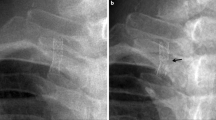Abstract
Background
Calcifications along ventricular catheters have been associated with shunt fractures although it is unknown whether their development predicts whether and when the shunts will fracture.
Objective
To determine whether extracranial calcifications found on a radiographic shunt series predicts whether a patient will experience a shunt catheter fracture or complication.
Materials and methods
A retrospective review was performed of pediatric patients with a ventricular shunt placed before 18 years of age and radiographic shunt series. Two thousand, six hundred and thirty shunt series in 523 patients (301 male) were reviewed to identify the development of calcifications around the catheter and fracture. Fifty-one patients were excluded for preexisting calcifications with shunt fracture. (48) Absence of shunt (2) or age (1). Analysis included descriptive statistics, odds ratio and chi-square test results.
Results
Four hundred seventy-two patients were included. Of the 59 shunts in 58 patients that developed calcifications, 23 went on to fracture (39%). Forty shunts without calcification in 37 patients developed fractures. There is a significant positive association between calcification and fracture (Χ2=39.1, P<0.01). It is 6.12 times more likely that a fractured shunt had calcifications compared to a non-fractured shunt having calcifications. Calcifications appeared within an average of 9 years, 10 months (range: 4-14 years) after shunt insertion. Shunt fractures occurred within an average of 5 years, 2 months (range: 6 months-9 years) after the appearance of calcifications with a median patient age of 14.6 years. Nearly all fractures were at or adjacent to the calcifications, most commonly in the neck (17/23; 73.9%).
Conclusion
Shunt calcification represents a significant risk for catheter fracture in the pediatric population. Early intervention or closer interval follow-up may be indicated in those found to have calcifications.



Similar content being viewed by others
References
Boockvar JA, Loudon W, Sutton LN (2001) Development of the Spitz-Holter valve in Philadelphia. J Neurosurg 95:145–147
Salim AD, Elzain MA, Mohamed HA, Ibrahim Zayan BE (2015) Shunt tube calcification as a late complication of ventriculoperitoneal shunting. Asian J Neurosurg 10:246–249
Paff M, Alexandru-Abrams D, Muhonen M, Loudon W (2018) Ventriculoperitoneal shunt complications: a review. Interdisc Neurosurg 13:66–70
Yamamoto S, Ohno K, Aoyagi M et al (2002) Calcific deposits on degraded shunt catheters: long-term follow-up of V-P shunts and late complications in three cases. Childs Nerv Syst 18:19–25
Lee L, Low S, Low D et al (2016) Late pediatric ventriculoperitoneal shunt failures: a Singapore tertiary institution's experience. Neurosurg Focus 41:E7
Reddy GK, Bollam P, Caldito G (2014) Long-term outcomes of ventriculoperitoneal shunt surgery in patients with hydrocephalus. World Neurosurg 81:404–410
Stone JJ, Walker CT, Jacobson M et al (2013) Revision rate of pediatric ventriculoperitoneal shunts after 15 years. J Neurosurg Pediatr 11:15–19
Dave P, Venable GT, Jones TL et al (2019) The preventable shunt revision rate: a multicenter evaluation. Neurosurgery 84:788–798
Boch AL, Hermelin E, Sainte-Rose C, Sgouros S (1998) Mechanical dysfunction of ventriculoperitoneal shunts caused by calcification of the silicone rubber catheter. J Neurosurg 88:975–982
Kural C, Kirik A, Pusat S et al (2012) Late calcification and rupture: a rare complication of ventriculoperitoneal shunting. Turk Neurosurg 22:779–782
Dean AG, Sullivan KM, Soe MM (2013) OpenEpi: Open Source Epidemiologic Statistics for Public Health, Version 3.01. www.OpenEpi.com. Accessed 17 Dec 2018
Irving IM, Castilla P, Hall EG, Rickham PP (1971) Tissue reaction to pure and impregnated silastic. J Pediatr Surg 6:724–729
Echizenya K, Satoh M, Murai H et al (1987) Mineralization and biodegradation of CSF shunting systems. J Neurosurg 67:584–591
Stannard MW, Rollins NK (1995) Subcutaneous catheter calcification in ventriculoperitoneal shunts. AJNR Am J Neuroradiol 16:1276–1278
Baird C, O’Connor D, Pittman T (1999) Late shunt infections. Pediatr Neurosurg 31:269–273
Bakhsh A (2011) CSF shunt complications in infants–an experience from Pakistan. Pediatr Neurosurg 47:93–98
Drake JM, Kestle JR, Milner R et al (1998) Randomized trial of cerebrospinal fluid shunt valve design in pediatric hydrocephalus. Neurosurgery 43:294–303
Miranda P, Simal JA, Menor F et al (2011) Initial proximal obstruction of ventriculoperitoneal shunt in patients with preterm-related posthaemorrhagic hydrocephalus. Pediatr Neurosurg 47:88–92
Shah SS, Hall M, Slonim AD et al (2008) A multicenter study of factors influencing cerebrospinal fluid shunt survival in infants and children. Neurosurgery 62:1095–1103
Çakir E, Kuzeyli K, Usul H et al (2004) Shunt dysfunction due to calcification of a ventriculo-peritoneal shunt: a case report. J Clin Neurosci 11:210–211
Agrawal A, Rao GM (2014) Letter to the editor. Subcutaneous shunt catheter calcification: an uncommon cause of shunt failure. Saudi J Med Med Sci 2:125–126
Elisevich K, Mattar AG, Cheeseman F (1994) Biodegradation of distal shunt catheters. Pediatr Neurosurg 21:71–76
Aldrich EF, Harmann P (1990) Disconnection as a cause of ventriculoperitoneal shunt malfunction in multicomponent shunt systems. Pediatr Neurosurg 16:309–312
Wu Y, Green NL, Wrensch MR et al (2007) Ventriculoperitoneal shunt complications in California: 1990 to 2000. Neurosurgery 61:557–563
Author information
Authors and Affiliations
Corresponding author
Ethics declarations
Conflicts of interest
None
Additional information
Publisher’s note
Springer Nature remains neutral with regard to jurisdictional claims in published maps and institutional affiliations.
Rights and permissions
About this article
Cite this article
Siddiqui, M.A., Hardy, A.K., Mercier, P.A. et al. Association between ventricular shunt catheter calcifications and the development of shunt fracture. Pediatr Radiol 49, 1773–1780 (2019). https://doi.org/10.1007/s00247-019-04488-0
Received:
Revised:
Accepted:
Published:
Issue Date:
DOI: https://doi.org/10.1007/s00247-019-04488-0




